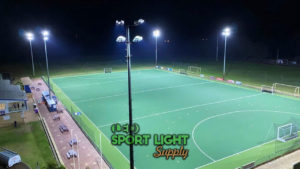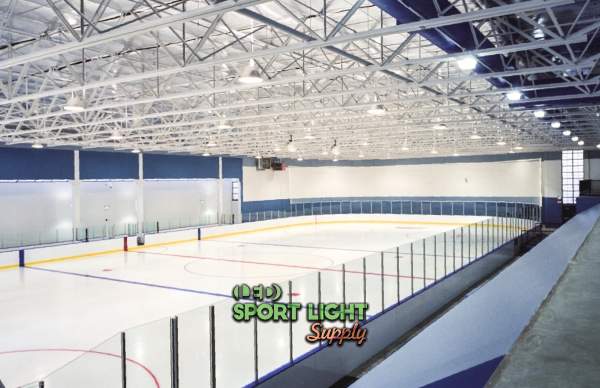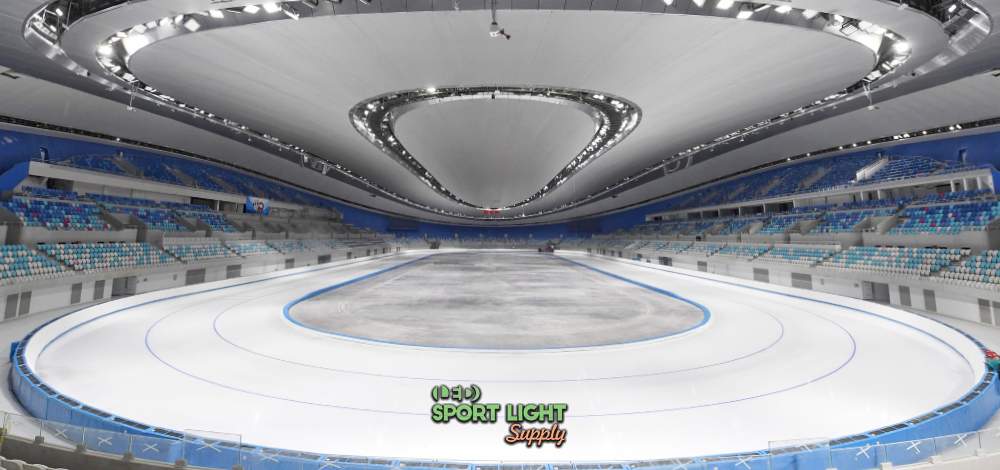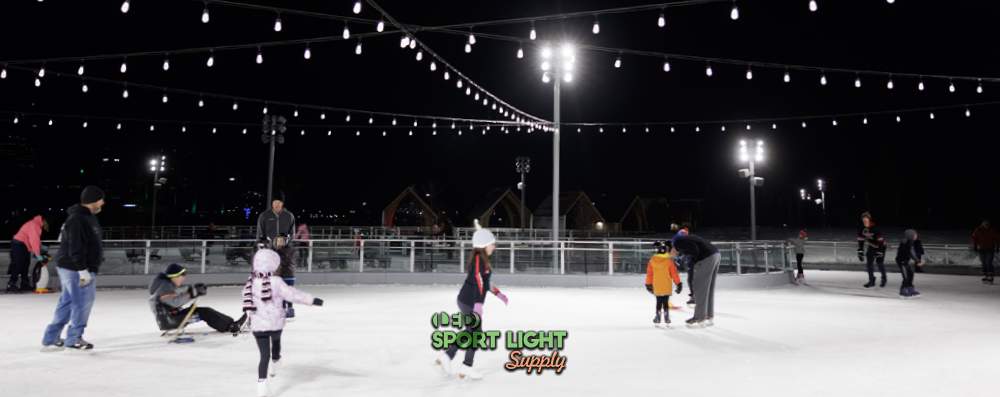
The standards for rink lighting are influenced by several factors, such as the level of the game, visibility, energy efficiency, and the reflective nature of the ice surface.
| Aspect | Recommended Range/Standard |
|---|---|
| Illuminance (Lux) | 1,000 – 1,200 lux (Game Play) |
| 600 – 800 lux (Training/Practice) | |
| Color Temperature (Kelvin) | 4,000 – 6,500 K (Neutral to Cool White) |
| Color Rendering Index (CRI) | 80 or higher |
| Uniformity Ratio | 0.6 – 0.8 |
Table of Contents
Toggle For competitive ice hockey, the recommended illuminance levels are determined by governing bodies such as the International Ice Hockey Federation (IIHF) and the Illuminating Engineering Society (IES). These organizations recommend achieving an average horizontal illuminance ranging from 1,000 to 1,200 lux for gameplay. This level of brightness is necessary to ensure that players can track the puck, judge the speed of the game, and make quick decisions on the ice.
For competitive ice hockey, the recommended illuminance levels are determined by governing bodies such as the International Ice Hockey Federation (IIHF) and the Illuminating Engineering Society (IES). These organizations recommend achieving an average horizontal illuminance ranging from 1,000 to 1,200 lux for gameplay. This level of brightness is necessary to ensure that players can track the puck, judge the speed of the game, and make quick decisions on the ice.
Higher illuminance also serves an important role in enhancing the viewing experience for spectators, especially those watching through television broadcasts. The brightness is critical for cameras to capture clear and sharp images, enabling viewers to follow the action without difficulty. Rinks must also meet these illuminance standards to provide a professional and consistent setting for competitive games, as lighting directly impacts the flow of the game and its overall quality.
During training and practice sessions, the illuminance level can be adjusted to a lower range of 600 to 800 lux. This provides enough visibility for players to practice their skills, but at a reduced brightness that allows rink operators to save on energy costs. While the lighting intensity is not as high as in competitive gameplay, it still ensures adequate clarity for players and coaches.
The lower illuminance in training sessions does not interfere with the players’ ability to perform drills or practice their routines, making it a more cost-effective option. The flexibility in lighting levels also allows rinks to adjust according to the specific needs of each session, balancing visibility and energy efficiency.
The color rendering index (CRI) is an important factor in ice hockey rink lighting, as it ensures accurate color representation. A CRI of 80 or above is recommended for ice hockey rinks, as this standard helps to distinguish different elements on the ice. This is particularly important for players who need to clearly see the puck against the ice surface and differentiate the colors of the players’ uniforms.
A high CRI also assists officials in making accurate calls during the game, as they need to clearly distinguish players and actions on the ice. The lighting must support the visibility of fast-moving objects, like the puck, which can often be difficult to spot in low-quality lighting. The importance of the CRI cannot be overstated, as it directly impacts both the safety and performance of players and the accuracy of officiating.
Uniform lighting across the ice surface is necessary to provide a consistent and fair playing environment. The International Illuminating Engineering Society (IES) suggests a uniformity ratio of at least 2:1 for ice hockey rinks. This means that the minimum illuminance should not be less than half of the average illuminance. A high uniformity ratio ensures that players are not forced to play under uneven lighting conditions, reducing the likelihood of dark spots or areas of the ice that are too bright.
Lighting uniformity also impacts how players perceive the game, as varying light intensities can lead to confusion or difficulty in tracking the puck or assessing the ice surface. Uniform lighting makes it easier for players to adjust to the environment, leading to more consistent performance across the rink. For spectators, uniform lighting ensures that the game is captured from every angle, with no disruptions in visibility.

Shadows can significantly impact gameplay, especially in fast-paced sports like ice hockey. Uniform lighting plays a role in reducing the creation of shadows on the ice, ensuring that players have an unobstructed view of the entire rink. Shadows can make it difficult for players to spot the puck or anticipate the movements of other players, thus affecting their ability to react in real-time.
Proper placement of lights, along with the use of high-quality reflectors and diffusers, can reduce the risk of shadows. Lighting systems designed to minimize shadows help create a more reliable playing environment and reduce distractions that may hinder a player’s performance. Ensuring that the light intensity is evenly distributed throughout the rink can go a long way in improving the game’s flow and the players’ ability to make split-second decisions.
The reflective nature of the ice surface presents unique challenges for rink lighting. Ice reflects light in such a way that it can lead to glare or uneven lighting across the rink, which in turn affects visibility and the players’ focus. To manage this issue, rink operators often rely on specialized reflectors and diffusers, which help distribute light more evenly across the surface.
The goal is to minimize glare while maximizing the lighting efficiency. Glare can distract players, making it difficult to track the puck or see other players. It can also cause discomfort for spectators, detracting from the viewing experience. Careful planning of the lighting layout and fixture positioning is essential for minimizing glare and ensuring that light is diffused evenly across the entire rink.
The placement of lighting fixtures is another factor that affects visibility and glare in ice hockey rinks. Fixtures must be positioned in a way that prevents direct light from hitting players’ eyes, which could be distracting, especially during high-speed plays. Overhead lighting is typically used in many rinks, but strategic placement is required to ensure that players are not exposed to direct light that could impair their focus or cause discomfort.
Lighting systems designed with glare control features, such as diffusers, louvers, or indirect lighting, help to maintain a balanced light distribution and reduce the risk of direct light interference. Proper placement and design of the lighting fixtures enhance both player performance and spectator comfort.
In ice hockey rinks, glare can be a significant issue, especially due to the highly reflective ice surface. To manage glare, rink lighting systems must include fixtures that are specifically designed to reduce direct light exposure and prevent excessive brightness that can distract players.
The use of fixtures with built-in glare control mechanisms, such as frosted covers, louvers, or diffusers, is one way to ensure that the light is evenly distributed and not overly intense. Glare reduction is particularly important during competitive games, where players need to maintain focus on the puck and other players without being distracted by harsh lighting. Additionally, glare can be uncomfortable for spectators, especially in arenas where the lights may be directed toward the audience as well as the ice.

LED technology has revolutionized the way ice hockey rinks are lit, offering both energy efficiency and long-term financial benefits. LEDs consume up to 50% less energy compared to traditional metal halide lamps, making them an attractive option for rink operators looking to reduce energy costs. In addition to their lower energy consumption, LED fixtures also have a longer lifespan, which reduces the need for frequent bulb replacements and lowers maintenance costs.
The efficiency of LED lights helps to reduce the overall environmental impact of rink operations. With the increasing focus on sustainability, many rinks are making the switch to LED lighting systems as part of their efforts to lower carbon footprints. While the initial installation costs of LED lighting systems may be higher than traditional options, the long-term savings on energy and maintenance can make up for this initial investment.
When considering the installation of LED lighting in an ice hockey rink, rink management must weigh the upfront costs against the long-term savings. Although LED fixtures are typically more expensive to install, their energy efficiency and extended lifespan result in significant savings over time. Reduced energy consumption means lower utility bills, while fewer replacements and repairs help minimize maintenance expenses. These financial benefits make LED lighting a wise investment for rink operators looking to optimize their budgets while maintaining high standards for gameplay and visibility.
The ability to control lighting levels and color temperature with LED technology also provides flexibility in managing different types of events, from competitive games to casual practice sessions. Rink operators can adjust the lighting to suit the needs of the event, optimizing both energy efficiency and lighting quality.
Maintaining the lighting system is crucial for ensuring that the lighting quality remains consistent throughout the lifespan of the rink. Regular maintenance involves checking the performance of the lighting fixtures, cleaning lenses or covers, and replacing bulbs or components as needed. Timely maintenance helps to avoid any disruptions that could affect the quality of gameplay or the rink’s operation.
For ice hockey rinks, where lighting plays a major role in game performance and spectator enjoyment, any decrease in lighting quality can have a noticeable impact. Rink operators should schedule regular inspections of the lighting system, keeping an eye on the overall condition of the fixtures and ensuring that all areas of the ice are adequately illuminated. Additionally, cleaning fixtures helps maintain the maximum light output and reduces the risk of performance issues that might arise due to dirt or debris accumulation.
Whether for competitive games or practice sessions, maintaining the right illuminance levels, ensuring high color rendering, and controlling glare and uniformity are all integral aspects of rink lighting. The adoption of energy-efficient LED lighting further enhances rink operations, providing significant long-term savings and environmental benefits. Regular maintenance ensures that the lighting system continues to meet the required standards, supporting both the quality of the game and the efficiency of the rink. By paying attention to these factors, rink operators can create a lighting setup that benefits players, officials, and spectators alike, ensuring a high-quality and cost-effective environment for all ice hockey activities.
Drop us a line to receive a free lighting design